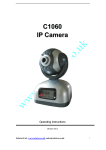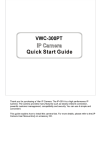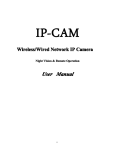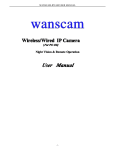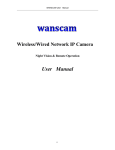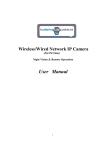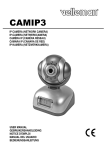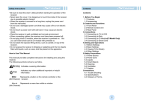Download IP Camera User Manual
Transcript
V Series— IP Camera USER MANUAL Version V1.0 Release 1 Index 1 2 INTRODUCTION ...................................................................................................................... - 1 1.1 WELCOME TO THE IP CAMERA .............................................................................................- 1 - 1.2 IDENTIFY IP CAMERA ...........................................................................................................- 2 - FUNCTIONS AND FEATURES.............................................................................................. - 8 2.1 BASIC FUNCTIONS ................................................................................................................- 8 - 2.2 ADVANCED FEATURES ..........................................................................................................- 9 - 3 SYSTEM REQUIREMENT...................................................................................................... - 9 - 4 SETUP PROCEDURE........................................................................................................... - 10 - 5 6 7 4.1 IP CAMERA POWER & NETWORK CONNECTION ..................................................................- 10 - 4.2 ROUTER/SWITCH/HUB/XDSL MODEM CONNECTION .........................................................- 11 - 4.3 USE IPCAMSEARCH TOOL TO SETUP IP CAMERAS .............................................................- 12 - 4.4 VIEW VIDEO ON WEB BROWSER.........................................................................................- 14 - 4.5 SETUP IP CAMERA ON WEB ................................................................................................- 16 - 4.6 MOUNTING THE IP CAMERA ...............................................................................................- 16 - SYSTEM CONFIGURATION................................................................................................ - 17 5.1 SYSTEM STATUS ..................................................................................................................- 17 - 5.2 USER MANAGEMENT ..........................................................................................................- 18 - 5.3 NETWORK ...........................................................................................................................- 19 - 5.4 DATE AND TIME ..................................................................................................................- 19 - 5.5 VIDEO .................................................................................................................................- 20 - 5.6 JPEG ENCRYPTION .............................................................................................................- 20 - 5.7 E-MAIL ...............................................................................................................................- 22 - 5.8 FTP ....................................................................................................................................- 23 - 5.9 SENSORS AND MOTION DETECTION ....................................................................................- 23 - 5.10 SCHEDULER TRIGGER .........................................................................................................- 24 - 5.11 SYSTEM MAINTENANCE .....................................................................................................- 24 - 5.12 SYSTEM LOG ......................................................................................................................- 25 - 5.13 GUEST ZONE .......................................................................................................................- 25 - VISIT IP CAMERA OVER INTERNET ................................................................................ - 26 6.1 WAN IP ADDRESS ..............................................................................................................- 26 - 6.2 NETWORK ADDRESS TRANSLATION (NAT).........................................................................- 27 - 6.3 PORT FORWARDING .............................................................................................................- 27 - 6.4 DEFAULT GATEWAY ............................................................................................................- 28 - 6.5 ACCESSING MULTIPLE CAMERAS OVER THE INTERNET ......................................................- 28 - 6.6 DYNAMIC DOMAIN NAME SERVICE (DDNS)......................................................................- 29 - 6.7 CONFIGURATION EXAMPLE .................................................................................................- 30 - TECHNICAL PARAMETERS ............................................................................................... - 31 - 2 Figures and Tables Index Figure 1 IP Camera 45-angle View ...................................................................................... - 2 Figure 2 IP Camera Front View ........................................................................................... - 2 Figure 3 IP Camera Back View ............................................................................................ - 3 Figure 4 Front View Indication and Operation .................................................................... - 3 Figure 5 LCD Indications..................................................................................................... - 4 Figure 6 IP Address/Network Mask/Gateway loop show .................................................... - 4 Figure 7 Back View Indication............................................................................................. - 6 Figure 8 Input & Output defines .......................................................................................... - 6 Figure 9 Input & Output Pins Connection ........................................................................... - 7 Figure 10 Insert a CF Card................................................................................................... - 8 Figure 11 Connecting the Ethernet wire............................................................................. - 10 Figure 12 connecting the power supply ............................................................................. - 11 Figure 13 LAN connection................................................................................................. - 11 Figure 14 IP Camera Search Tool ...................................................................................... - 12 Figure 15 Modify IP Camera’s IP Address......................................................................... - 13 Figure 16 Input Administrator’s Username and Password................................................. - 13 Figure 17 IP Camera Home Page ....................................................................................... - 14 Figure 18 Login Message box............................................................................................ - 14 Figure 19 Video webpage................................................................................................... - 15 Figure 20 History Images View ......................................................................................... - 16 Figure 21 System Status View............................................................................................ - 17 Figure 22 User Management View..................................................................................... - 18 Figure 23 Network Setup View.......................................................................................... - 19 Figure 24 Date and Time Setup View ................................................................................ - 19 Figure 25 Video Setup View .......................................................................................... - 20 Figure 26 JPEG Encryption Setup View ............................................................................ - 20 Figure 27 Require Password Input in Client Web Browser................................................ - 21 Figure 28 Input Password in Web Browser (ActiveX)....................................................... - 21 Figure 29 Input Password in Web Browser (Java) .......................................................... - 21 Figure 30 E-mail Setup View ............................................................................................. - 22 Figure 31 FTP Setup View ................................................................................................. - 23 Figure 32 Sensors and Motion Detection Setup View........................................................ - 23 Figure 33 Scheduler Trigger Setup View ........................................................................... - 24 Figure 34 System Maintenance View................................................................................. - 24 Figure 35 System Log View............................................................................................... - 25 Figure 36 “Guest Zone” View............................................................................................ - 25 Figure 37 IP Camera’s Application Environment .............................................................. - 26 Figure 38 Typical Network Environment........................................................................... - 30 - 3 1 Introduction 1.1 Welcome to the IP Camera The IP Camera combines a high quality digital video camera with network connectivity and a powerful web server to bring clear video to your desktop from anywhere on your local network or over the Internet. Your IP Camera package should contain the following items, If any of the listed items are missing, please contact your reseller from where you purchased the camera for assistance. The package includes. 9 IP Camera *1 9 IP Camera Utility CD *1 9 5V Power Adapter *1 9 Stand of plastic*1 9 1.5 meter cable*1 -1- 1.2 Identify IP Camera Figure 1 IP Camera 45-angle View Lens Tilt Night Vision LEDs Pan Working Status LED Privacy Indicate LED User Visiting LED Privacy Status Button IP Show LCD Figure 2 IP Camera Front View -2- RJ45 Ethernet Socket Input&Output Pins DC 5V Input Socket CF Card Socket RESET Button Figure 3 IP Camera Back View LED: Privacy LED: Working Button: Privacy LED: User Visiting LCD Figure 4 Front View Indication and Operation The privacy button toggles Privacy mode and Normal mode, In Privacy mode, all the remote users will not be allowed to see the video. -3- Figure 5 LCD Indications LCD will loop show IP Address/Network Mask/Gateway, as shown in the Figure 6. IP Address=192.168.0.24 Subnet mask=255.255.255.0 Gateway IP=192.168.0.1 Figure 6 IP Address/Network Mask/Gateway loop show -4- Status icon indications list: Icon Meaning DDNS Server Registered. Connected to the INTERNET successfully. Backbone server connected successfully. There is/are user(s) visiting IP Camera video. Sensor triggered. (Digit input or Motion detection) CF card detected. System in firmware. configuration status. E.g. Upgrading Network mode indications: Icon Meaning Static IP Use static (manually fixed) IP mode. DHCP IP Address is dynamically assigned by DHCP Server. PPPoE IP Camera’s internal PPPoE dial function enabled.(Used for xDSL) Working status LED meaning: LED Status Meaning Normal Flashing: Turns on for 1/2 second every 3 seconds Normal running Always on or always off System error Fast Flashing: Turns on for 1/2 second every 1 second System is starting, Please wait. Slow Flashing: Turns on for 1/2 second every 6 second Upgrading firmware, Please wait. -5- DC 5V Input Socket RJ45 Ethernet Socket Input & Output Pins CF Card Socket Reset button Figure 7 Back View Indication Output Pins Relay: Normally Open Digit Input Pins 1 Output A 2 B 3 Input 1 4 Common 5 Input 2 Figure 8 Input & Output defines -6- Input Pins: The input pins can be used for 2-way external sensor input. For example, you may connect a Person Infrared Sensor (PIR) to it for motion detection. When external sensor triggered, IP Camera can be programmed to send an email with picture or control the internal relay output. Input pins can connect 2 sensors. The sensor should provide open/close signal only. The two lines of sensor 1 should connect to Pin 3 & Pin 4; the two lines of sensor 2 should connect to Pin 5 & Pin 4. Output Pins: IP Camera has an internal relay. Relay’s two normally open contacts are represented by Pin 1 and Pin 2. You may use it to control one external load below AC/DC 36V & 2 Amp. While connecting input and output pins, strip off the protect rubber of wire for 5mm, the use a small screwdriver to depress and latch down the orange tabs over holes, Insert the red wire into hole until the insulation just reaches the back of the camera, use the screwdriver to press down and release the orange tab above hole locking the wire in place. Repeat the steps for other wires. Figure 9 Input & Output Pins Connection External Power Socket:Connect to a 5V AC-DC adapter. CAUTION: Make sure to only use the power adapter supplied with your IP Camera. Using a non-approved power adapter may damage the camera. RJ-45 Ethernet Socket: Connects your IP Camera to LAN. -7- CF Card Socket: Insert a Compact Flash Card for scheduler or sensor trigger’s images storage. Support volume is 1MByte to 2GByte. CF Card should be format as FAT16/FAT32 before inserted. Figure 10 Insert a CF Card Caution: IP Camera DO NOT allow plug/unplug CF Card when power up. You must unplug IP Camera’s power before operating CF Card. Note: Please keep in mind, not all brand and mode’s CF card can work with IP Camera, please take a test before purchase. RESET button: Click the reset button shortly, will reboot the system. If you press the button and hold for 5 seconds or longer, the system will restore to factory default configuration, it will take about 30 seconds, then reboot automatically. Caution: DO NOT switch off IP Camera’s power during the procedure of restoring factory default. It will take about 30 seconds. 2 Functions and Features 2.1 Basic Functions The IP Camera and your home or business network form a powerful audio/video remote monitoring solution. Just place the IP Camera anywhere on your network, power it up, and -8- it’s ready to be accessed by any PC on the network running web browser. The IP camera utilizes MJPEG hardware compression, brings 30fps@VGA resolution live video to you. The built-in pan and tilt, live streaming audio, and snapshot/video capture functions can all be controlled directly from the camera’s on-board homepage. Capability for motion detection with e-mail notification may be added by purchasing an optional motion detector. Use the IP Camera to keep an eye on your home or business when you can’t be there. Give friends and relatives a window into your world or monitor and record anything from anywhere on the Internet. 2.2 Advanced Features 9 Advanced Image Encryption Besides basic web authority mechanism, IP Camera provide an 128-bit AES encryption to the images transportation, ensures your information security. 9 Digital Video Recording and Transportation IP Camera can store images to CF Card, or, send images to your mailbox when triggered. 9 Motion Detection Your may use the internal Motion Detection function or external PIR sensor to trigger images recording and transportation. 9 Relay Output Control The internal relay can be used to control external devices according to your setting. 9 DDNS support IP Camera provides dynamic DNS function, thus you may use it in xDSL environment. 3 System Requirement 9 9 9 9 9 9 9 9 LAN: 10Base-T Ethernet / 100BaseTX Fast Ethernet Web Browser can support ActiveX ,such as Internet Explorer 5.0 or higher, Web Browser can support Java Applet, such as Firefox 1.5 PC – Intel Pentium III or equivalent, 1GHz or above 128MB RAM 800x600 resolution with 16-bit color or above Windows 2000, Windows XP, Linux Other device: read-only CD-ROM -9- Note: Not only the fixed IP address can access cameras from the Internet, but also Dynamic IP can access cameras. If the IP address provided by your Internet Service Provider is dynamic (changing), then signing up for a dynamic DNS service will make accessing from the Internet much more convenient. 4 Setup Procedure Before use IP Camera, please setup according to the following procedures. 4.1 IP Camera Power & Network Connection Plug the included Ethernet cable into the RJ-45 connector at the back of the camera as shown. Figure 11 Connecting the Ethernet wire Connect the power supply to the back of the camera as shown, and then plug the supply into an available power outlet. - 10 - Figure 12 connecting the power supply CAUTION: Make sure to only use the power adapter supplied with your IP Camera. Using a non-approved power adapter may damage the camera. In different country or region, the power supply might be different (110V/220, 50Hz/60Hz), please make sure it correspond to the tag marked on the power adapter. 4.2 Router/Switch/Hub/xDSL Modem Connection Plug the other end of the Ethernet cable into any available LAN port. A typical home router/gateway connection is shown below. The LED of LAN port will then turns ON. Figure 13 LAN connection - 11 - Check the LEDs on the RJ45 socket of IP Camera. If connection is ok, the green LED turns on. If there’s any active data transportation, the orange LED will flash. The LCD panel of IP Camera will show IP Camera’s current IP address/Network Mask/Gateway. IP Camera is available for visiting now. You have two methods to visit its homepage: 1) Run IPCamSearch Tool in the CD. This software will search for all IP Cameras in your LAN. Select one and then click [visit] to continue. 2) Run an Internet Explorer, and input the IP address as shown on the LCD to IE’s address bar, for example: http://192.168.0.234. Note: IP Camera by default use fixed (static) IP address setting. The default IP address is :192.168.0.234, Network Mask is 255.255.255.0, Gateway is 192.168.0.1 4.3 Use IPCamSearch Tool to setup IP Cameras Put the supplied CD into your CDROM, Click and run IPCamSearch.exe Tool. Figure 14 IP Camera Search Tool This tool shows all IP Cameras found on your LAN with its Serial Number/IP Address/Firmware Version. If your IP Camera’s IP address is not as the same segment of your PC(defined by IP Address and Network Mask), you may not be able to visit your IP Camera. For example, Your PC’s IP address is 192.168.100.33, network mask is 255.255.255.0, then your PC will only reach IP address 192.168.100.1 to 192.168.100.255, If your IP Camera’s IP Address is not within this range, you cannot - 12 - access it. Then you may click [Setup IP] button to change IP Camera’s IP address to adopt your PC setting. Click [Auto Set], let IPCamSearch.exe tool find an available IP Address for you. Figure 15 Modify IP Camera’s IP Address Click [OK], and then input administrator’s username and password to continue. Figure 16 Input Administrator’s Username and Password Note: By default, administrator’s username is: admin, password is: 123456 Input the correct username and password, and click [OK], then you can see a message box indicating IP Camera’s IP Address has changed(IP Camera is in static IP mode now). Then you may click [Visit IPCam] to run an Internet Explorer, You can do more configuration by click [System Setup] on homepage of IP Camera. - 13 - Note: If you don’t have IPCamSearch.exe tools at hand, you may change your PC’s IP Address to the same segment, according to the IP shown on IP Camera’s front LCD. Then you can input IP Camera’s IP Address into IE’s address bar to access. 4.4 View Video on Web Browser You may visit IP Camera’s homepage by IE or other compatible web browsers. Figure 17 IP Camera Home Page Click “User Visit” to view video. You will see a message box which requires your login as shown below. Figure 18 Login Message box - 14 - Note: By default, administrator’s username is: admin, password is: 123456 Input correct Username and password, then you can view the video. If you are using IE ActiveX mode, for the first time, you will be alert to install ActiveX control. Click [Install] to continue. After ActiveX Control Installed, you will see the following. Figure 19 Video webpage On the top-left of the web page is a pan/tilt control, you can click to move the camera Up/Down/Left/Right, and left-right cruise180 degree or top-down cruise120 degree, or return to home position. Note, Do not cruise long time continually. On the left, you can also select the Resolution, Quality, Brightness, Contrast and Zoom. Resolution can be 640x480, 320x240, and 160x120. The higher resolution, the higher clarity, while requiring more bandwidth. Quality can be “High”, “Standard” or “Low”. “High” consumes largest bandwidth, thus the frame per second will down. If you feel the frame per second (fps) is too slow, and hope to increase it, you may select “Low” quality and lower resolution. If you hope to see clearer image, you may choose “High” quality and higher resolution. Brightness and Contrast can be changed according to different environment. “+” means add, “-” means reduce. “STD” means a standard (middle) value. - 15 - Zoom will show the video in a scale of half or double. It won’t affect the transport fps or bandwidth. Click [Snapshot] will pop up a new page to snap a static JPEG image, you may click right key of mouse and select “save as…” to store it to your computer. Click [History], will pop up a History View Page (You must have inserted CF Card first). Figure 20 History Images View 4.5 Setup IP Camera on Web You can click [System Setup] to modify all parameters. See the Chapter 5 for details . 4.6 Mounting the IP Camera The IP Camera can sit on a flat surface, such a shelf or bookcase, be mounted to a wall using the included bracket, or mounted atop a tripod stand using the standard tripod mount located on the underside of the base. When using the camera free standing, be sure to secure the cables. Failing to secure the cables could cause the camera to be pulled off the mounting surface resulting in damage to the camera. CAUTION: The IP Camera should be mounted indoors or inside a weatherproof enclosure. Outdoor exposure may result in damage and will void your warranty. CAUTION: Don’t mount the IP Camera with the lens facing into direct sunlight. Prolonged exposure to direct sunlight will damage the sensor. - 16 - The mounting bracket included with your camera provides convenient mounting to vertical surfaces, such as walls. The camera support platform can be tilted up or down to help point the camera toward your area of interest. You can also rotate the camera in any direction on the platform. Step 1. Find a suitable location to mount the camera. Step 2. Using the mounting bracket as a guide, mark the location of the two mounting holes. Step 3. Drill a ¼” hole for each screw. Step 4. Use a hammer to tap the two plastic anchors into the holes. Step 5. Use the two screws to fasten the bracket to the wall. Step 6. Place the camera on the mounting bracket platform and rotate the camera to be facing in the desired direction. Step 7. Secure the camera to the mounting bracket using the thumbscrew located on the bottom of the platform. Step 8. Loosen the tilt adjust thumbscrew and tilt the camera toward the area to be observed. 5 System Configuration 5.1 System status This page shows status of the system for diagnose. Figure 21 System Status View - 17 - 5.2 User Management Figure 22 User Management View “User name”: Determine the username of visitor who can log in. The administrator can set up to 16 case sensitive character names. “Password”: Set up a password for the visitor account. The password must be between one and sixteen bytes which is English and number. “Authority”: Determine the permission lever to “Administrator”, “User”, “Guest” or “Disabled”. Administrator: This permission allows the user full access including write permission to all the sections. User: This permission level allows the user access to IP Camera menus, but without the permission to setup. Guest: This permission level allows the user to access IP Camera’s video only. The user does not have any permission to change. disabled Make the user account disable, no access. ”Allow Anybody Visit”: IP Camera provide a Guest Zone, if you checked this, any temporally visitors may enter Guest Zone to see the video without input any username/password. If you unchecked this (default), the visitors have to enter at least a “Guest” permission username/password to visit the “Guest Zone”. At any time, the “User Zone” only allows “User” & “Administrator” permission to visit. - 18 - 5.3 Network Figure 23 Network Setup View 5.4 Date and Time Figure 24 Date and Time Setup View - 19 - 5.5 Video Figure 25 Video Setup View 5.6 JPEG Encryption Figure 26 JPEG Encryption Setup View - 20 - Figure 27 Require Password Input in Client Web Browser Figure 28 Input Password in Web Browser (ActiveX) Figure 29 Input Password in Web Browser (Java) - 21 - 5.7 E-mail Figure 30 E-mail Setup View This section sets up the necessary Email server information. The administrator will have to enter a valid Account Name and Password to the Email server. This information is necessary to allow email notification features. “SMTP Server”: The administrator will have to enter the Email server address here. “Sender’s Email”: This will determines IP Camera’s Email address. “Email Requires Authentication”: If checked, the administrator will have to provide the account name and password in order to access the Email server. “E-mail Sender Username”: Enter the account name or login name to the Email server. “E-mail Sender Password”: Enter the password for the above account name. - 22 - 5.8 FTP Figure 31 FTP Setup View 5.9 Sensors and Motion Detection Figure 32 Sensors and Motion Detection Setup View - 23 - 5.10 Scheduler Trigger Figure 33 Scheduler Trigger Setup View 5.11 System Maintenance Figure 34 System Maintenance View - 24 - 5.12 System Log Figure 35 System Log View 5.13 Guest Zone Figure 36 “Guest Zone” View - 25 - 6 Visit IP Camera over INTERNET IP Camera is often used in this environment: 1) In Local Area Network (LAN) only. 2) Direct connect to INTERNET via xDSL (PPPoE) Modem. 3) Share one INTERNET connection with other computer, and connect to INTERNET via a gateway or router. Figure 37 IP Camera’s Application Environment If your LAN is connected to the Internet through a high speed (broadband) Internet connection, you can access your cameras by web browser from anywhere on the Internet. To do this you need to: 1) Know your WAN (Internet) IP address. This is the IP address that your Internet Service Provider gives you to access the Internet. It may be static (always the same) or dynamic (can change from time to time). 2) Make sure the port used by the camera (80) is forwarded by your router or gateway to the camera. 3) Make sure your camera’s default gateway is set to the LAN (local) IP address of your router/gateway. 6.1 WAN IP Address The WAN (Wide Area Network) IP address that your Internet Service Provider grants you so that you can access the Internet is very different from the LAN or local IP address that your PCs and cameras are using to connect to your local network. Your WAN or Internet IP address is visible to the outside world (Internet) whereas your local addresses are not. To find your home or business network from the Internet you must know your WAN IP address. - 26 - Your WAN IP address is stored by your gateway router which uses it to connect to the Internet. All the devices on your network connect to the Internet via your gateway router. You can find your current WAN IP address by checking your router’s status page. There are also various websites such as www.whatismyip.com which will tell you the IP address that you are currently using to access the Internet. The term gateway is used generically to mean the device that connects a local network to the Internet. A gateway may be a router, a PC running software which allows it to act as a gateway such as a proxy server, or some other device. Most home networks use a NAT (Network Address Translation) router as a gateway. The term gateway router refers to such a device. Static versus Dynamic IP address The IP address (or addresses) your ISP has provided you will either be static, which means it never changes, or dynamic, meaning it can change periodically. Dynamic addresses present an additional challenge when trying to locate your network from the Internet since your address may have changed since the last time you checked it. How often your dynamic address changes vary from one service provider to another. Also, any time you reboot your cable or DSL modem, your are likely to get a new address when reconnecting. The solution to the ever changing IP address is known as DDNS or dynamic domain name service. A DDNS will allow you to find your network by a domain name, such as http://tom.vipcam.cn, rather than needing to know the IP address. 6.2 Network Address Translation (NAT) Most home routers and business firewalls today perform something called NAT or Network Address Translation. NAT translates your external or WAN IP address into an internal address inside your gateway router. What this means is, you can think of your router as being divided into two halves, the LAN side (inside) and the WAN side (outside or Internet side). When a connection request arrives at your router from the Internet, it will not get any farther than the WAN side unless you have specifically instructed your router to pass this type of request to a specific device on your LAN. This process is known as port forwarding or port redirecting. 6.3 Port Forwarding All TCP/IP (Internet) networking uses software ports. Ports can be thought of as channels on your television. By default, all web page traffic is on channel (port) 80. By default, the IP Camera uses port 80 to deliver its web page to your browser. Therefore, both of these channels (ports) must be open (not blocked by your router/firewall) to incoming traffic in order for you to connect to the camera from the Internet. Also, these two ports must be forwarded or redirected to the camera’s LAN IP address by your gateway router. Your router’s setup software should provide a utility for port forwarding or redirecting. - 27 - Before setting up port forwarding, it’s best to configure your IP Camera to use a static LAN IP since your port forwarding setup will need to be updated if the camera’s LAN IP address changes. Note: Forwarding ports to your camera does not pose any additional security risk to your LAN. 6.4 Default Gateway Devices (PCs, cameras, etc.) on your network connect to the Internet via a gateway. For most home networks, a NAT type router serves as the gateway. For business LANs, the gateway may be a PC running gateway software. In order for any device on your network to get connected to the Internet, it must know the LAN IP address of your gateway. If your camera is set up to use DHCP, then it will retrieve this information automatically from your router. However, if you have configured your camera to use a static IP address, you must also be sure that you have set the correct gateway IP address in order to connect your camera to the Internet. Note: It may not be possible to test WAN (Internet) access to your cameras from a PC connected to the LAN. To be sure that your cameras are accessible by the Internet, you should contact someone you know with Internet access (preferable broadband) and have them enter your WAN IP address into their browser. You camera is now live on the Internet. Browsing your camera from the Internet is the same as browsing on your LAN except that you must enter your WAN IP address (or camera domain name if you’ve set up a DDNS service) instead of the LAN IP address. 6.5 Accessing Multiple Cameras over the Internet When accessing multiple cameras over the Internet, you must assign separate port numbers for each camera. The reason for this is simple. Your gateway router needs some way of knowing which camera to direct an incoming request to. Unless directed otherwise, your browser will always send web page requests to port 80. Since port 80 can only be forwarded to one LAN IP address, all incoming web page requests on port 80 will go to this address. The solution to this problem is to set up the router, assign a different port number to each camera. For example, you may set up your second camera to use port 81. When you want to access this camera, you would tell your browser to use port 81, instead of port 80. In your router’s port forwarding setup, you would need to forward port 81 to the LAN - 28 - IP address of the second camera. Web page requests arriving at port 81 will automatically be directed to the second camera’s address. To instruct your browser to use a different port, other than 80, to access a web page, you would add the port number at the end of the IP address or URL, separated by a colon. For example, to access a camera on port 81 if your WAN IP address is 210.82.13.21, you would enter http:// 210.82.13.21:81 into your browser’s address bar. You can do the same thing with a URL such as http://tom.vipcam.cn:81. The steps to set up remote access are as follows: 1) Go to your gateway router setup page and configure port forwarding to port 81 to LAN IP address of Camera_1(e.g. 192.168.0.151) and port 82 to the LAN IP address of Camera_2(e.g. 192.168.0.152). 2) From somewhere on the Internet, bring up Internet Explorer and enter your WAN IP address followed by a colon and the port number such as: http://210.82.13.21:81 to access Camera_1. Note: Some routers use port 80 for remote configuration and it’s possible to experience a conflict when using port 80 for camera access. Therefore, you should use port 81 for your first camera, port 82 for the second, etc... This setup also makes it easier to remember which camera is using a particular port number. 6.6 Dynamic Domain Name Service (DDNS) Your Internet Service Provider (ISP) provides you at least one IP address which you use to connect to the Internet. The address you get may be static, meaning it never changes, or dynamic, meaning it’s likely to change periodically. Just how often it changes, depends on your ISP. A dynamic IP address complicates remote access since you may not know what your current WAN IP address is when you want to access your network over the Internet. The solution to the dynamic IP address problem comes in the form of a dynamic DNS service. The Internet uses DNS servers to lookup domain names and translates them into IP addresses. Domain names, such as www.vipcam.cn, are just easy to remember aliases for IP addresses. A dynamic DNS service is unique because it provides a means of updating your IP address so that your listing will remain current when your IP address changes. There are several excellent DDNS services available on the Internet and best of all most are free to use. Two such services you can use are www.3322.org and www.vipcam.cn . You’ll need to register with the service and set up the domain name of your choice to begin using it. Please refer to the home page of the service for detailed instructions. Note: The writing of the base decals have already applied for the DDNS and passwords from http://www.vipcam.cn. - 29 - A DDNS service works by uploading your WAN IP address to its servers periodically. Your gateway-router may support DDNS directly, in which case you can enter your DDNS account information into your router and it will update the DDNS servers automatically when your IP address changes. Please consult your router’s documentation for more information. If your router does not support DDNS, you can setup the IP Camera’s DDNS client. 6.7 Configuration Example At home or business LAN, one or more computers and IP Cameras are connected to the same IP Sharing Device(Gateway/Router), IP Sharing Device was assigned a public IP Address by ISP(e.g. 210.82.13.21), while each devices in LAN has assigned a different LAN IP(e.g. 192.168.0.151/192.168.0.10/192.168.0.11). INTERNET Remote PC xDSL Modem IP Sharing Device Public: 210.82.13.21 Privacy:192.168.0.1 IPCamera 192.168.0.151 PC1 192.168.0.10 PC2 192.168.0.11 Figure 38 Typical Network Environment Now, every LAN devices connect to INTERNET via NAT function provided by IP Sharing Device. However, from the point of remote PC’s view, remote PC see only an IP Sharing Device, it doesn’t know how many PCs existed inside privacy LAN. This IP Sharing Device is also acted as a firewall. Thus, we have changed the setting of IP Sharing Device; let public PC has the opportunity to access LAN devices, e.g. IP Camera. We can achieve this goal by enable Reversal NAT (RNAT) function of IP Sharing Device. 1) “Virtual Server”: Many routers have “Virtual Server” support. You must forward the - 30 - WAN 80 TCP port to LAN IP Camera’s IP and Port. (If you visit 210.82.13.21’s 80 port outside, you will be forward to LAN 192.168.0.2’s 80 port). 2) Another method is the “DMZ Host”. If enabled to use a LAN device as the DMZ host, the outside PC will be able visit this LAN device directly, as if there is no IP Sharing Device exists. This method support only one LAN device exposed to the WAN. Thus, if you have more IP Cameras, you have to use the above method. Configuration Example: Take D-Link (http://www.dlink.com) DI-604/DI-614+/DI-624 as an example. 1) Login to your router; 2) In WAN configuration, input the PPPoE username and password provided by your ISP; 3) Click Advanced on Top of homepage; 4) Click Virtual Server (Note: If you use Virtual Server mode, you must turn DMZ host function off first. DMZ Host function will disable all Virtual Server function) 5) Input the following information on page: Enabled/Disabled: Enabled Name: VilarCamera Private IP: Input IP Camera’s Address, e.g. 192.168.0.151 Protocol Type: TCP Private Port: 80 Public Port: 80 Schedule: Always 6) Click Apply to save. IP Camera can be accessed in WAN. 7 Technical Parameters Items Description Video Video Input Single high quality CMOS Sensor (30,0000 pixels) Compression Motion-JPEG FPS 30 frame per second (640x480) maximum. Resolution VGA (640x480) CIF (320x240) QCIF (160x120) Optional 160x120@10fps : 300 kilobits ~ 480 kilobits Typical Bandwidth 320x240@10fps : 640 kilobits ~ 960 kilobits 640x480@10fps : 3.2 Megabits ~ 4.8 Megabits - 31 - 160x120@30fps : 900 kilobits ~ 1.44 Megabits 320x240@30fps : 1.92 Megabits ~ 2.88 Megabits 640x480@30fps : 9.6 Megabits ~ 14.4 Megabits Interface Digital Input 2-way Open/Close Input Relay Output 1-way Relay Output(36V AC/DC, 2A) Connection 5 Pins Network Interface Protocol Ethernet 10/100Base-T RJ-45 Transport: RTP/IP,UDP/IP,TCP/IP,SMTP/HTTP/FTP Other: DNS and DHCP client, DDNS Power Supply 5V DC Consumption 5W Maximum Physical Temperature 0℃~45℃ Humidity 50℃ 95% Management System Setup Web Page Upgrade Firmware upgrade by Web Other CPU 32bit ARM@66MHz frequency. SDRAM 16MByte FLASH 4MByte - 32 -



































